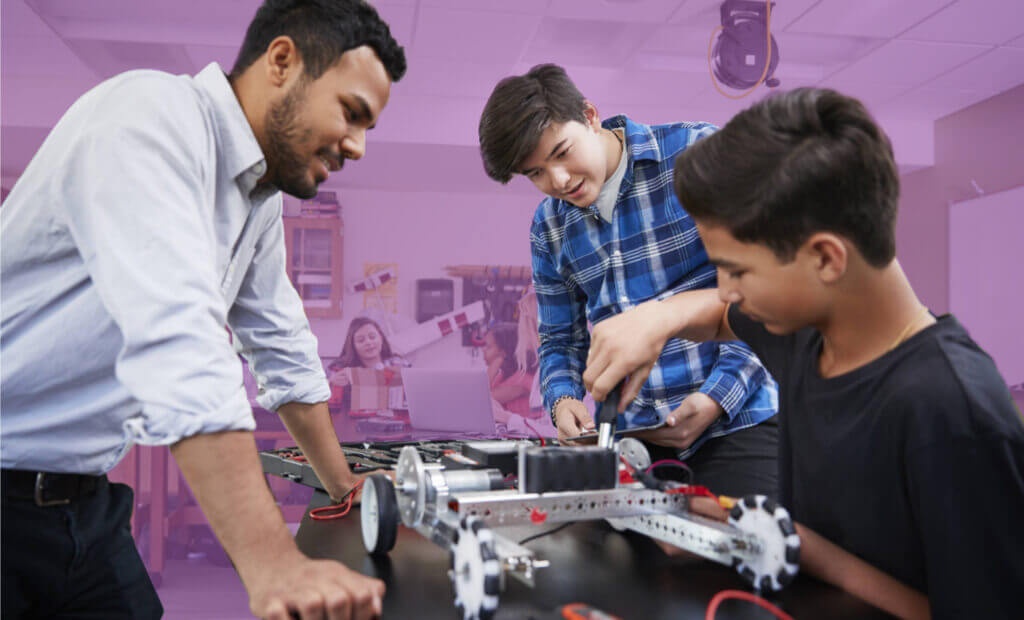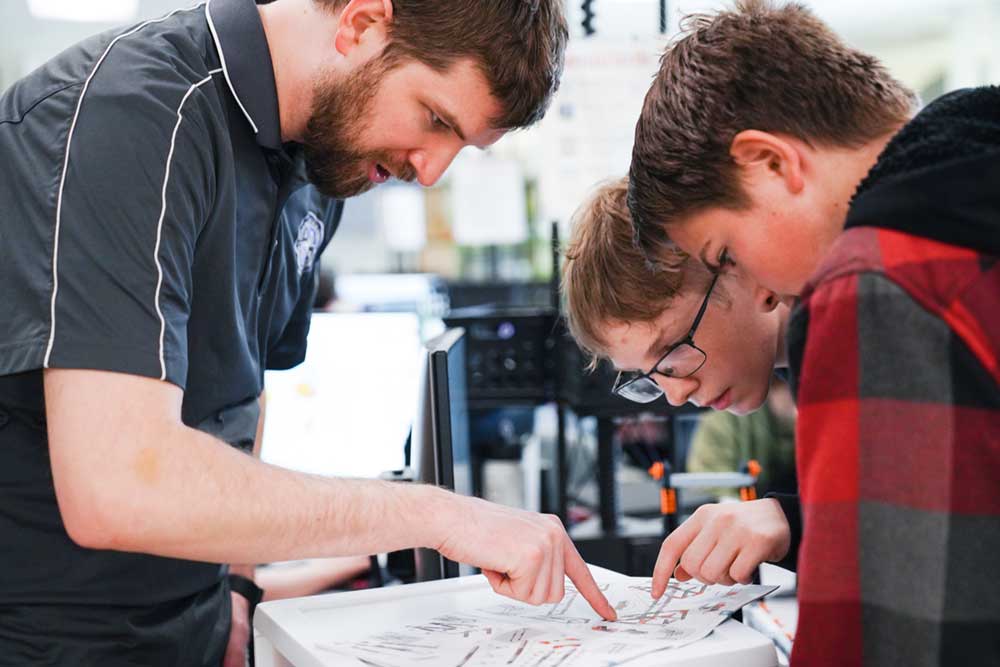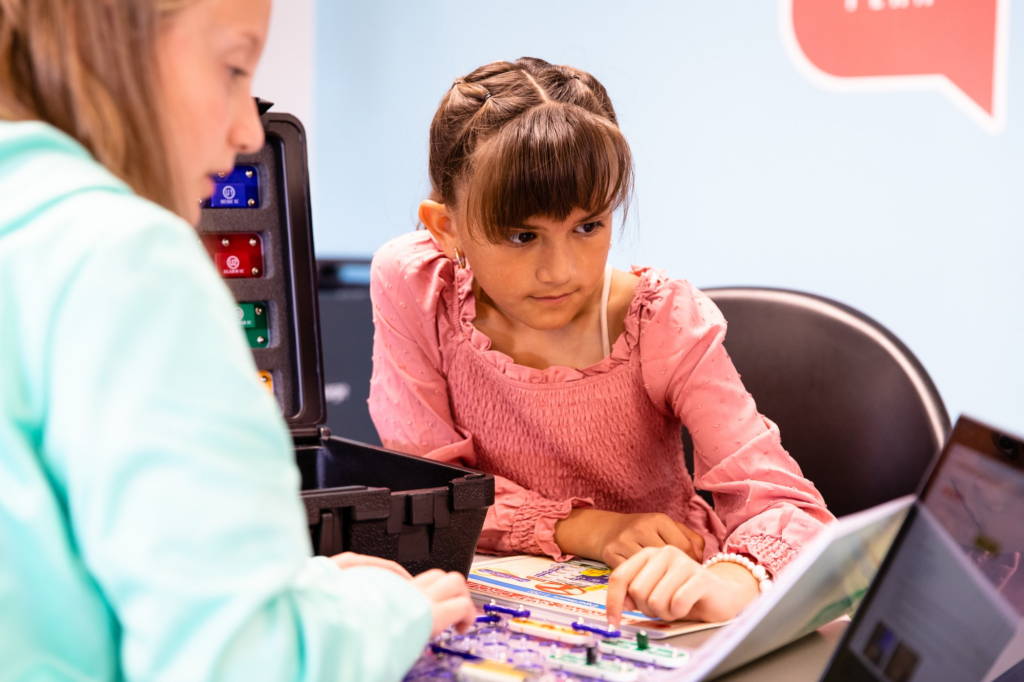Formative Assessment in PBL: Checking for Understanding Throughout the SmartLab Learning Process
In college, all educators learn about formative and summative assessment. And when we transition into classrooms of our own, we get plenty of practice assessing our students’ understanding with a variety of assessment tools: worksheets, Exit Tickets, quizzes, tests.
Assessment is not a new instructional strategy for educators. The process is simple. You teach, you gather data as students practice, you provide feedback and reteaching, and then you test.
But when you implement project-based learning and your students are suddenly developing different solutions and working at different paces, it no longer seems so simple.
In this article, we’re going to talk about the most impactful type of assessment, formative assessment, in the context of PBL + STEM. We will talk about what makes it effective and show you how to keep formative assessment simple in the SmartLab HQ.
Making an Impact with Formative Assessment
Formative assessment is defined by the CCSSO1 as “a planned, ongoing process used by all students and teachers during learning and teaching to elicit and use evidence of student learning to improve student understanding of intended disciplinary learning outcomes and support students to become self-directed learners.”
This commonly used teaching strategy has the potential to accelerate student achievement2. I highlight “potential” here because the implementation of this strategy is key.
Too often, assessment is categorized as formative because it occurs during the learning process or before the big test. I gave them a quiz before the test, so there’s my formative assessment. Done!
But the timing itself isn’t what makes formative assessment an impactful strategy for student learning. According to Jan Chappuis, an expert in classroom assessment, it’s all about:
- Alignment with learning goals
- What you learn from it
- How and when you use information learned3
How and when you use information gathered from formative assessment is the true catalyst for the shift from assessment of learning to assessment for learning.
Not sure how you’re doing with formative assessment? Use the questions below, which are based on Jan Chappuis’s five conditions for effective formative assessment 3, to identify specific areas for focus to “level up” your formative assessment.
Self-Assess Your PBL Formative Assessment
Yes/No
- Is it aligned to the learning goals or content standards?
(Use the Scope and Sequence to identify I CAN statements and targeted standards.) - Is it aligned with what my students are actually learning throughout the project?
- Does it provide helpful information that identifies areas for growth or targeted support?
- Does it provide information with enough time to do something about it, i.e. before the project cycle ends or summative assessment occurs?
- Is it followed by “doing something about it” through guided revision, prompting with questions, sharing resources, etc.?
Step 1: Explore
During the Explore step, students explore the technology they will use and the project they will complete. They make connections to their background knowledge and consider what they don’t know yet but may need to know for this project.
| Use this step in the SmartLab Learning Process to: | Do this by: | Use this information to: |
|---|---|---|
| • Collect information about their current background knowledge • Identify misconceptions | • Observing student interactions with technology • Listening to student conversations • Asking students: What do you already know about…? What do you wonder about…? What questions do you have about…? What vocabulary is unfamiliar? • Reviewing submissions for the Explore assignment in LearningHub | • Informally pre-assess mastery of learning goals (I CAN statements) • Gather additional resources • Plan mini conferences (see example below) |
EXAMPLE (Middle School)
Matthew and Damien are exploring the parts of the fischertechnik STEM Renewable Energies kit. You hear them identify the solar panel and wind turbine, but they’re unsure of what the water wheel does. The pair discuss how cool it would be to power their phone with one of the sources. Matthew thinks the wind turbine would be better because it’s windy where they live. Damien retorts with, “Well, it’s pretty sunny here, too! And solar energy makes more electrical energy than wind energy.”
Facilitator Planning Based on the Project Learning Goals:
I CAN compare different forms of green energy.
Resources to Share:
- What You Should Know page – section on hydropower
Questions to Ask:
- How does hydropower work?
- How does that connect to the water wheel in this model?
- How is this similar or different from solar and wind energy?
- How are these renewable energy sources similar and different?
- If you wanted to use these energy sources to power your phone, what would you have to consider for each (space, resources, cost, existing technology, etc.)
I CAN design an experiment to collect quantitative and qualitative data about my energy source.
Resources to Share:
Questions to Ask:
- Which energy source would be better for your project?
- How could you test that? Will you collect quantitative or qualitative data?
- Why is that kind of data most helpful for this experiment
- What data would you need to collect to test your hypothesis?
Step 2: Plan
During the Plan step, students plan their project, set SMART goals, determine the outcome, and identify the steps to reach it.
| Use this step in the SmartLab Learning Process to: | Do this by: | Use this information to: |
|---|---|---|
|
• Develop a shared understanding of the learning goals and success criteria • Align student SMART goals and project learning goals |
• Reviewing project learning goals (I CAN statements)
• Asking students: What do you need/want to know or be able to do by the end of the project? What will success look like? How will you know when you’ve met your goal? • Reviewing submissions for the Plan and SMART Goal assignment in LearningHub • Prompting revision to SMART goals |
• Gather additional resources
• Develop questions to monitor understanding (see example below) |
EXAMPLE (Elementary)
Amaya’s SMART Goal: I will build an alarm system that will play a sound and flash a light when sound is detected. This is important to us because we are designing an alarm to protect our community garden from deer. We need to know what parallel and series circuits are and which kind we should use in our circuit.
Questions to Ask Amaya:
- What did you learn about parallel and series circuits?
- How are these circuits different?
- What happens to the loads (light and sound) when you use a parallel circuit?
- What about a series?
- When would that be an advantage or disadvantage?
- How does it apply to your goal?
Steps 3 & 4: Do & Reflect
| Use this step in the SmartLab Learning Process to: | Do this by: | Use this information to: |
|---|---|---|
| • Compare current understanding and skill development to learning goals |
• Asking students: What do you know now that you didn’t know when you started? How do you know…? Why is that important? How does it connect to your project? • Reviewing submissions for the Daily Project Journal assignment in LearningHub |
• Determine resources to use • Prompt mini conference • Clarify misconceptions |
EXAMPLE (High School)
Myriam and Micah’s Daily Project Journal Submission: Today, we began creating our tiny house in Homestyler (online 3D home design program). We learned that each square in Homestyler represents six inches. We got most of the first floor done, but tomorrow we have to figure out how to create the second floor. When we’re done, we’re going to have to figure out how to find the square footage.
Mini Conference Plan:
-
Ask about Homestyler scale and how it relates to their sketch on graph paper
- Yesterday you learned that each square in Homestyler represents one foot. How does that scale ratio relate to the scale ratio for your sketch? How do you know you’re designing it to scale in Homestyler?
- Support square footage calculation
- What is the total square footage? Why is that important to know? How will you use that information? How do you calculate the square footage? What information do you need to know to find the total square footage?
-
Point students back to the What You Should Know page for Tinkercad:
- Scale Models (scale ratio information) and Home Depot’s resource for calculating square footage
Step 5: Share
During the Share step, students share and celebrate their learning as they describe what did and didn’t work and transfer knowledge to their peers and teachers.
| Use this step in the SmartLab Learning Process to: | Do this by: | Use this information to: |
|---|---|---|
| • Look for evidence of learning goal mastery (I CAN statements) | • Asking questions based on I CAN statements • Whole class or small group presentations • Project submission in LearningHub (3-12th grade) | • Set long-term goals • Plan follow-up opportunities for learning and mastery *Summative assessment will occur during this step. |
EXAMPLE (Primary)
At the end of the project cycle, Mr. Ruiz’s first grade class reflects on their learning and what they want to keep working on.
Marcus, the SmartLab Facilitator, provides each pair with a sentence frame and guides them to fill it out:
We are still learning ________________. During the next project, we want to _____________.
Hana and Hai reflect on the 2D shapes they built with Geometric Shapes: We are still learning how to describe shapes. During the next project, we want to learn the names of shapes with 7, 8, and 9 sides!
Tips for Formative Assessment in the SmartLab:
- Use the Scope and Sequences in LearningHub to identify project learning goals (I CAN statements) and develop guiding questions.
- Build your formative assessment question bank over time! Record only the ones that elicit helpful information.
- Prompt learners to use the What You Should Know page in each project starter to answer questions and fill in gaps in background knowledge.
- Don’t grade formative assessments! Research shows that when grades accompany feedback, students ignore the feedback as a learning tool and instead use it to justify the grade they received4.
While each project has its conclusion and students inevitably move on to new ones, it’s essential to note that it doesn’t mark the final chance for students to excel in content knowledge and skills, such as those outlined in the Core Skills Articulation.
The SmartLab HQ Scope and Sequence follows a spiral pattern through the Areas of Exploration, progressively introducing more intricate project starters and technology. This method allows students multiple occasions within a grade range to revisit fundamental concepts and put crucial skills into practice.
Resources
- Formative Assessment for Students and Teachers (FAST) State Collaborative on Assessment and Student Standards (SCASS). (2018). Revising the Definition of Formative Assessment. https://ccsso.org/resource-library/revising-definition-formative-assessment
- Corwin Visible Learning Plus. (2023, June). Formative evaluation. https://www.visiblelearningmetax.com/influences/view/formative_evaluation
- Chappuis, J. (2009). Seven Strategies of Assessment for Learning. Boston, Pearson Education.
- LSI Dylan Wiliam Center, (2014, November 29). Is the Feedback You’re Giving Students Helping or Hindering? https://www.dylanwiliamcenter.com/2014/11/29/is-the-feedback-you-are-giving-students-helping-or-hindering/





